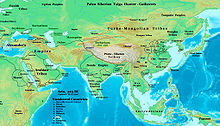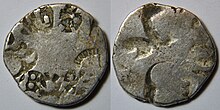Nanda Empire
Nanda Empire | |||||||||||
|---|---|---|---|---|---|---|---|---|---|---|---|
| 345 BCE–321 BCE | |||||||||||
 The Nanda dynasty at its greatest extent under Dhana Nanda c. 325 BCE. | |||||||||||
| Capital | Pataliputra | ||||||||||
| Common languages | Old Indic Languages (e.g. Magadhi Prakrit, Other Prakrits) Sanskrit | ||||||||||
| Religion | Hinduism (Brahmanism) Buddhism Jainism[1] | ||||||||||
| Government | Monarchy | ||||||||||
| Historical era | Iron Age India | ||||||||||
• Established | 345 BCE | ||||||||||
• Disestablished | 321 BCE | ||||||||||
| |||||||||||
| Today part of | |||||||||||


| History of India |
|---|
 |
| Timeline |
| History of South Asia |
|---|
 |
The Nanda dynasty originated from the region of Magadha in ancient India during the 4th century BCE and lasted between 345–321 BCE. At its greatest extent, the empire ruled by the Nanda Dynasty extended from Bengal in the east, to the Punjab region in the west and as far south as the Vindhya Range.[2] The rulers of this dynasty were famed for the great wealth which they accumulated. The Nanda Empire was later conquered by Chandragupta Maurya, who founded the Maurya Empire.
Establishment of the dynasty
Mahapadma Nanda, who has been described in the Puranas as "the destroyer of all the Kshatriyas",[3] defeated many other kingdoms, including the Panchalas, Kasis, Haihayas, Kalingas,[a] Asmakas, Kurus, Maithilas, Surasenas and the Vitihotras; to name a few.[6] He expanded his territory south of the Vindhya Range into the Deccan Plateau. The Nandas, who usurped the throne of the Shishunaga dynasty c. 345 BCE,[7] were thought to be of low origin.[8] He was the son of Mahanandin, and a Shudra mother.[9][3]
Military
The Nanda kings built on the foundations laid by their Haryanka and Shishunaga predecessors to create the first great empire of north India.[1] To achieve this objective they built a vast army, consisting of 200,000 infantry, 20,000 cavalry, 2,000 war chariots and 3,000 war elephants (at the lowest estimates).[10][11][12] According to the Greek historian Plutarch, the size of the Nanda army was even larger, numbering 200,000 infantry, 80,000 cavalry, 8,000 war chariots, and 6,000 war elephants.[11][13] However, the Nandas never had the opportunity to see their army face Alexander, who invaded North-western India at the time of Dhana Nanda, since Alexander was forced to confine his campaign to the plains of Punjab and Sindh, for his forces mutinied at the river Beas and refused to go any further upon encountering "the 4000 well trained and well equipped war elephants of the Gangaridei (Nanda)" according to Diodorus.[11][14]
A possible indication of Nanda military victories in Kalinga is suggested by the later Hathigumpha inscription of Kharavela, which mentions a King named Nanda building a canal and conquering a place. The existence of a place called Nau Nand Dehra (Nanded) on the Godavari is taken by some scholars as reflecting Nanda rule over the Deccan. The evidence for the extension of Nanda rule into trans-Vindhyan India is not, however, strong.[1]
Wealth
The Nandas were also renowned for their immense wealth. They undertook irrigation projects and invented standardized measures for trade across their empire, and they ruled with the assistance of many ministers.[a] The Nanda Dynasty was also mentioned in the ancient Sangam literature of the Tamil people. The famous Tamil poet Mamulanar described the capital city Pataliputra of the Nanda Dynasty and the wealth and treasure that was accumulated by the great Nanda rulers.[15] Their unpopularity, possibly due to their "financial extortion", facilitated a revolution, leading to their overthrow by Chandragupta Maurya and Chanakya. Nevertheless, "the greatness [...] attained in the Maurya Age would hardly have been possible but for the achievements of their predecessors", the Nandas.[a]
List of Nanda rulers
Jaina, Buddhist and Puranic sources all state that the Nanda kings were nine in all. But they differ in the details. The Buddhist Mahabodhivamsa lists the following as the nine Nandas:[1]
- Ugrasena (Mahapadma Nanda)
- Panduka
- Pandugati
- Bhutapala
- Rashtrapala
- Govishanaka
- Dashasiddhaka
- Kaivarta
- Dhana (Agrammes / Xandrames)
The Puranas claim that the first of the nine, Mahapadma was the father, while the rest were his sons. Only one of the sons, Sukalpa, is named. The Buddhist tradition also claims that the later eight were brothers.[1]
Courtiers
Jain and Hindu writers refer to a distinguished line of imperial chancellors or advisors of the king from Kalpaka to Sakatala and Rakshasa. The advisors of the king were fewer in number but were most respected on account of their high character and wisdom. They are mentioned by the Greek observers who wrote about conditions in the fourth century BCE. Next to the advisors were the 'generals of the army'; one such, Bhadrasala, is mentioned in the Milinda-Panho.[16]
In literature
A passage of the Kathasaritsagara refers to the kataka (camp) of Nanda in Ayodhya.[6] According to the Visarasreni of Merutunga, the Nandas rose to power in 467 BC.[17]
References
Notes
- ^ a b c Kalinga (India) formed part of the Nanda Empire but subsequently broke free until it was re-conquered by Ashoka Maurya, c. 260 BCE.[4][5]
Citations
- ^ a b c d e Upinder Singh 2016, p. 273.
- ^ Mookerji 1988, p. 28–33.
- ^ a b Mookerji 1988, p. 8.
- ^ Raychaudhuri & Mukherjee 1996, pp. 204–209.
- ^ Raychaudhuri & Mukherjee 1996, pp. 270–271.
- ^ a b Sastri 1988, p. 17.
- ^ Panda 2007, p. 28.
- ^ Mookerji 1988, p. 7.
- ^ Smith 1999, p. 39.
- ^ Mookerji 1988, p. 34.
- ^ a b c Sastri 1988, p. 16.
- ^ Gabriel, Richard A. (30 November 2002), The great armies of antiquity (1.udg. ed.), Westport, Conn. [u.a.]: Praeger, p. 218, ISBN 9780275978099
- ^ Raychaudhuri & Mukherjee 1996, pp. 204–210.
- ^ Kaushik, Roy (2015), Military Manpower, Armies and Warfare in South Asia "Warfare, Society and Culture", Routledge, p. 14, ISBN 1317321286
- ^ The First Spring: The Golden Age of India by Abraham Eraly p.62
- ^ Sastri 1988, p. 15.
- ^ Kailash Chand Jain 1991, p. 85.
Sources
- Jain, Kailash Chand (1991), Lord Mahāvīra and His Times, Motilal Banarsidass, ISBN 978-81-208-0805-8
- Mookerji, Radha Kumud (1988) [first published in 1966], Chandragupta Maurya and his times (4th ed.), Motilal Banarsidass, ISBN 81-208-0433-3
- Panda, Harihar (2007), Prof. H.C. Raychaudhuri, as a Historian, Northern Book Centre, ISBN 81-7211-210-6
- Raychaudhuri, H. C.; Mukherjee, B. N. (1996), Political History of Ancient India: From the Accession of Parikshit to the Extinction of the Gupta Dynasty, Oxford University Press
- Sastri, K. A. Nilakanta, ed. (1988) [1967], Age of the Nandas and Mauryas (Second ed.), Delhi: Motilal Banarsidass, ISBN 81-208-0465-1
{{citation}}: Unknown parameter|editorlink=ignored (|editor-link=suggested) (help) - Singh, Upinder (2016), A History of Ancient and Early Medieval India: From the Stone Age to the 12th Century, Pearson Education, ISBN 978-93-325-6996-6
- Smith, Vincent A. (1999), The Early History of India (third ed.), Atlantic Publishers and distributors, ISBN 978-81-7156-618-1
